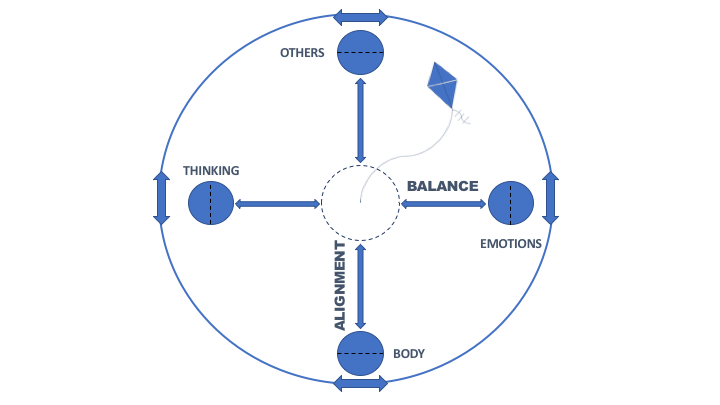The method I use describes the self as something that can be broken down into four parts – body, others, thinking and emotions.
In the introductory session the client details the outline of the issue which has brought him to therapy and from this point on we begin to explore his relationship to his body, to others, to his thinking and to his emotions. It will be seen that his unexplored history has informed the way he treats each of these relationships. Progress is made by recognising that many aspects of the self and how it functions have not been conscious choices but habits which are the consequence of the attachments and adjustments he has made in order to survive.

The line of alignment looks specifically at the relationship between the body and others. We will consider how much of the body is given to the service of others and how much is retained for the self. How much of these behaviours are freely chosen and how much are the result of habit?
The line of balance looks into the relationship between thinking and emotions. On what occasions does one inform the other? Is the client bullied by his thinking? Is he easily prey to his emotions?
The kite in the diagram is merely the space on which we place a word to assess a clients relationship to any given subject. We soon discover that his reaction to a certain word or term will work differently in each of these four aspects of the self. Such discoveries lead to valuable discussions helping the client to feel in balance and better able to cope with lifes’ challenges in an assured manner.
Process
In order to install a remodelling of the self we require four or five sessions. Each of the four aspects of the self are analysed in turn in the hour long sessions. The client is given a journal which he is encouraged to bring along to sessions. He is also given exercises to complete each week in order to deepen his understanding of his history and to explore the new relationship as they develop. After these sessions we review the progress which has been made and consider whether further steps are necessary and useful.

Case Example
A man comes to therapy concerned about the excessive amount of food or drink he is consuming. We begin not by focusing on questions of amount but on how much time he is bodily dedicating to others. It may be that he is vey much dedicated to meeting to needs of others and very little energy is given to looking after himself. He may be so ‘other-directed’ that most of his effort goes into making sure other people think well of him. This leaves little time for him to take care of himself. His thoughts are of course informed by his emotions. Whilst he would like to take a rational approach to his weight gain he is easily over-whelmed by his emotions – perhaps a resentment and repressed anger at the demands made of him by others – and as a result finds himself eating or drinking a great deal. Thus he momentarily escapes the present in food and drink which are his understandable but poorly chosen rewards. As a consequence of his increasing size he feels disappointed with himself but then has to work harder to gain the respect of others and thus the cycle repeats itself again.
Our approach to this problem is to explore the reasons why he has come to take these four relationships to himself. How did he learn his relationship to his body? What was he persuaded to take part in? How was he permitted to rest? What are food and exercise associated with? What were the significant others in his life as he grew up? Did he experience conflict and difficulty at home? Did he feel he was to blame for any break up while his growing rational sense knew he could not be? What relationship does he have to his thinking? Is he bullied by it or does he hear it making an equal contribution to his mode of being? What causes him to override its contribution? What emotions are difficult for him to be with? Is he easily shamed? Is it difficult for him to express him emotions to others? How does he mange this relationship or is it ignored?
Our aim is to help a man understand himself so that he leaves therapy with choices not compulsions. By stepping back from his four relationship habits he becomes better able to choose how to go forward and be at ease with himself.